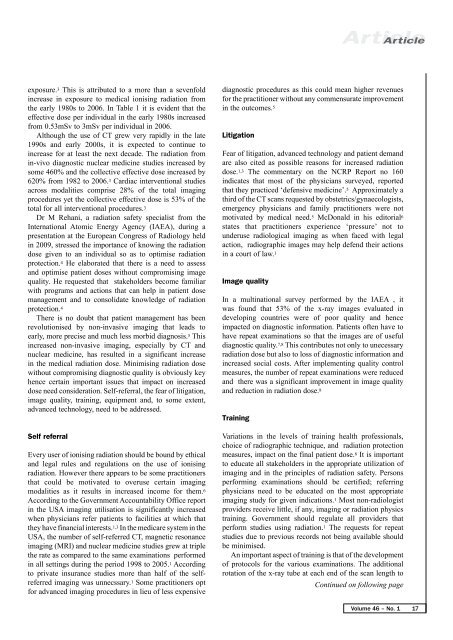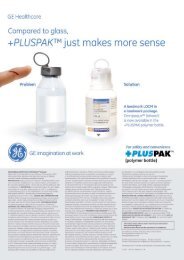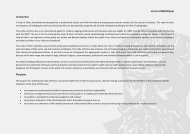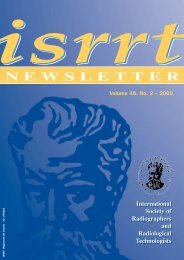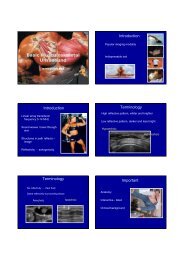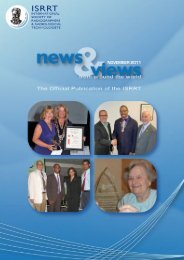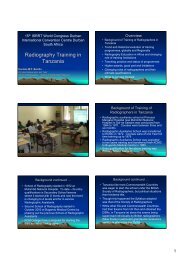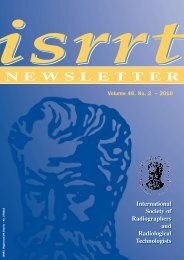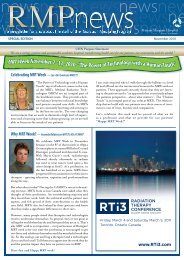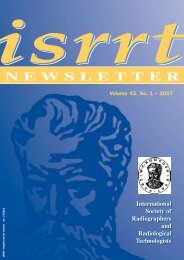images/isrrt/May 2010.pdf
images/isrrt/May 2010.pdf
images/isrrt/May 2010.pdf
Create successful ePaper yourself
Turn your PDF publications into a flip-book with our unique Google optimized e-Paper software.
Articleexposure. 3 This is attributed to a more than a sevenfoldincrease in exposure to medical ionising radiation fromthe early 1980s to 2006. In Table 1 it is evident that theeffective dose per individual in the early 1980s increasedfrom 0.53mSv to 3mSv per individual in 2006.Although the use of CT grew very rapidly in the late1990s and early 2000s, it is expected to continue toincrease for at least the next decade. The radiation fromin-vivo diagnostic nuclear medicine studies increased bysome 460% and the collective effective dose increased by620% from 1982 to 2006. 3 Cardiac interventional studiesacross modalities comprise 28% of the total imagingprocedures yet the collective effective dose is 53% of thetotal for all interventional procedures. 3Dr M Rehani, a radiation safety specialist from theInternational Atomic Energy Agency (IAEA), during apresentation at the European Congress of Radiology heldin 2009, stressed the importance of knowing the radiationdose given to an individual so as to optimise radiationprotection. 4 He elaborated that there is a need to assessand optimise patient doses without compromising imagequality. He requested that stakeholders become familiarwith programs and actions that can help in patient dosemanagement and to consolidate knowledge of radiationprotection. 4There is no doubt that patient management has beenrevolutionised by non-invasive imaging that leads toearly, more precise and much less morbid diagnosis. 5 Thisincreased non-invasive imaging, especially by CT andnuclear medicine, has resulted in a significant increasein the medical radiation dose. Minimising radiation dosewithout compromising diagnostic quality is obviously keyhence certain important issues that impact on increaseddose need consideration. Self-referral, the fear of litigation,image quality, training, equipment and, to some extent,advanced technology, need to be addressed.Self referralEvery user of ionising radiation should be bound by ethicaland legal rules and regulations on the use of ionisingradiation. However there appears to be some practitionersthat could be motivated to overuse certain imagingmodalities as it results in increased income for them. 6According to the Government Accountability Office reportin the USA imaging utilisation is significantly increasedwhen physicians refer patients to facilities at which thatthey have financial interests. 1,3 In the medicare system in theUSA, the number of self-referred CT, magnetic resonanceimaging (MRI) and nuclear medicine studies grew at triplethe rate as compared to the same examinations performedin all settings during the period 1998 to 2005. 1 Accordingto private insurance studies more than half of the selfreferredimaging was unnecssary. 1 Some practitioners optfor advanced imaging procedures in lieu of less expensivediagnostic procedures as this could mean higher revenuesfor the practitioner without any commensurate improvementin the outcomes. 5LitigationFear of litigation, advanced technology and patient demandare also cited as possible reasons for increased radiationdose. 1,3 The commentary on the NCRP Report no 160indicates that most of the physicians surveyed, reportedthat they practiced ‘defensive medicine’. 5 Approximately athird of the CT scans requested by obstetrics/gynaecologists,emergency physicians and family practitioners were notmotivated by medical need. 5 McDonald in his editorial 6states that practitioners experience ‘pressure’ not tounderuse radiological imaging as when faced with legalaction, radiographic <strong>images</strong> may help defend their actionsin a court of law. 1Image qualityIn a multinational survey performed by the IAEA , itwas found that 53% of the x-ray <strong>images</strong> evaluated indeveloping countries were of poor quality and henceimpacted on diagnostic information. Patients often have tohave repeat examinations so that the <strong>images</strong> are of usefuldiagnostic quality. 7,8 This contributes not only to unecessaryradiation dose but also to loss of diagnostic information andincreased social costs. After implementing quality controlmeasures, the number of repeat examinations were reducedand there was a significant improvement in image qualityand reduction in radiation dose. 8TrainingVariations in the levels of training health professionals,choice of radiographic technique, and radiation protectionmeasures, impact on the final patient dose. 8 It is importantto educate all stakeholders in the appropriate utilization ofimaging and in the principles of radiation safety. Personsperforming examinations should be certified; referringphysicians need to be educated on the most appropriateimaging study for given indications. 1 Most non-radiologistproviders receive little, if any, imaging or radiation physicstraining. Government should regulate all providers thatperform studies using radiation. 1 The requests for repeatstudies due to previous records not being available shouldbe minimised.An important aspect of training is that of the developmentof protocols for the various examinations. The additionalrotation of the x-ray tube at each end of the scan length toContinued on following pageVolume 46 – No. 1 17


